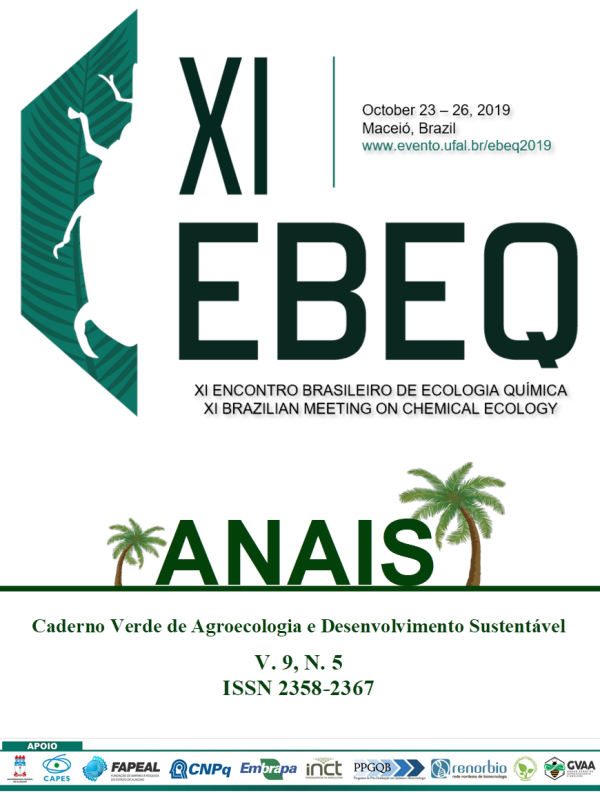COMPOSTOS ORGÂNICOS VOLÁTEIS (COVS) DE Costalimaita ferruginea (Fabricus, 1801) (COLEOPTERA: CHRYSOMELIDAE) EM Eucalyptus urograndis
Palavras-chave:
BESOURO DESFOLHADOR, EUCALIPTO, SEMIOQUÍMICOS, MONITORAMENTO, CONTROLE.Resumo
Uma das principais preocupações da eucaliptocultura no Brasil são os ataques de insetos-praga desfolhadores, dentre estes, destaca-se Costalimaita ferruginea (Fabricius, 1801) (Coleoptera: Chrysomelidae) que após surtos populacionais frequentes acaba prejudicando o desenvolvimento de povoamentos florestais de eucalipto. O controle desse inseto é feito principalmente, pelo uso de inseticidas. Em virtude disso, a utilização de semioquímicos surge como alternativa ecológica para o monitoramento e/ou controle de pragas. O objetivo desse estudo foi caracterizar os compostos orgânicos voláteis (COVs) de C. ferruginea coletados no estado de Alagoas. Para a obtenção dos voláteis, foram coletados adultos de C. ferruginea com idade e status reprodutivo (acasalados ou virgens) desconhecidos em povoamento florestal experimental clonal de E. urograndis, no Centro de Ciência Agrárias, Rio Largo, Alagoas. Foram utilizados dois grupos amostrais, o primeiro com 30 machos, e o segundo, com 30 fêmeas. Os insetos foram submetidos à coleta de voláteis através do sistema de aeração, em laboratório. Posteriormente, foi realizada a detecção e identificação dos COVs através de cromatografia gasosa com detector por ionização em chama (CG-DIC) e cromatografia gasosa acoplada a espectômetro de massas (CG-EM). Foram identificados um total de 22 compostos. Nos extratos obtidos da aeração, os compostos Tetradeceno e (Z)-9- ácido Octadecenoico foram específicos em amostras de machos de C. ferruginea. O composto Heptadecano foi específico para as fêmeas. Dessa maneira, os compostos emitidos por C. ferruginea e identificados no presente estudo, sugerem a presença de voláteis específicos de machos e fêmeas. A presença dessas substâncias, pode ser indicativa de feromônios sexuais. Sendo assim, necessário a realização de estudos adicionais para a consolidação e elucidação da ecologia química de C. ferruginea em E. urograndis.Downloads
Arquivos adicionais
Publicado
Como Citar
Edição
Seção
Licença
Termo de cessão de direitos autorias
Esta é uma revista de acesso livre, em que, utiliza o termo de cessão seguindo a lei nº 9.610/1998, que altera, atualiza e consolida a legislação sobre direitos autorais no Brasil.
O(s) autor(es) doravante designado(s) CEDENTE, por meio desta, publica a OBRA no Caderno Verde de Agroecologia e Desenvolvimento Sustentável, representada pelo Grupo Verde de Agroecologia e Abelhas (GVAA), estabelecida na Rua Vicente Alves da Silva, 101, Bairro Petrópolis, Cidade de Pombal, Paraíba, Brasil. Caixa Postal 54 CEP 58840-000 doravante designada CESSIONÁRIA, nas condições descritas a seguir:
O CEDENTE declara que é (são) autor(es) e titular(es) da propriedade dos direitos autorais da OBRA submetida.
O CEDENTE declara que a OBRA não infringe direitos autorais e/ou outros direitos de propriedade de terceiros, que a divulgação de imagens (caso as mesmas existam) foi autorizada e que assume integral responsabilidade moral e/ou patrimonial, pelo seu conteúdo, perante terceiros.
O CEDENTE mantêm os direitos autorais e concedem à revista o direito de divulgação da OBRA, com o trabalho simultaneamente licenciado sob a Licença Creative Commons do tipo atribuição CC-BY.
O CEDENTE têm autorização para distribuição não-exclusiva da versão do trabalho publicada nesta revista.
O CEDENTE têm permissão e são estimulados a publicar e distribuir seu trabalho online (ex.: em repositórios institucionais ou na sua página pessoal) a qualquer ponto antes ou durante o processo editorial, já que isso pode gerar alterações produtivas, bem como aumentar o impacto e a citação do trabalho publicado.








